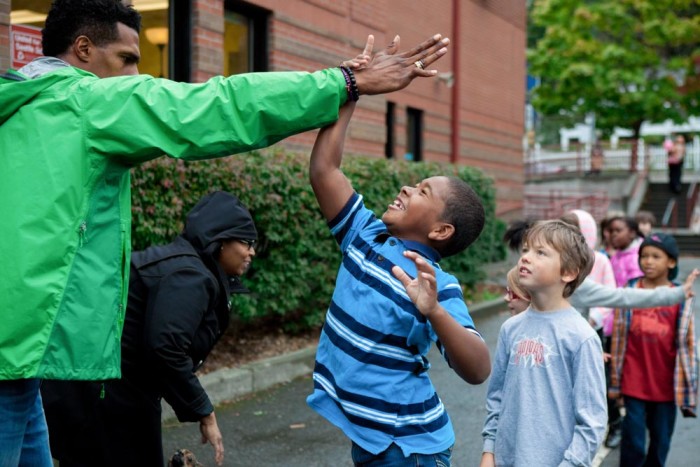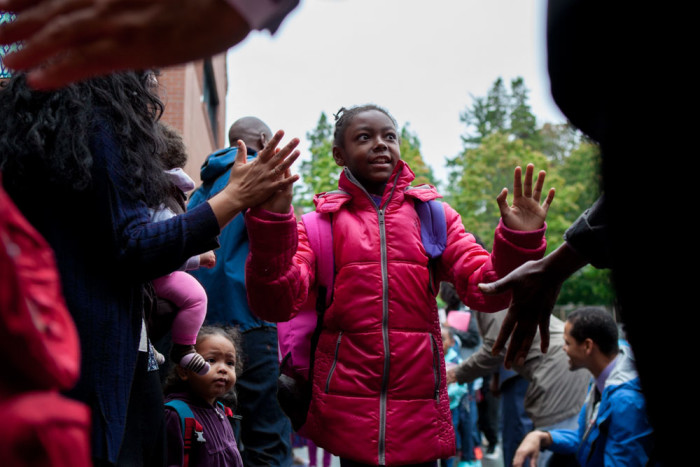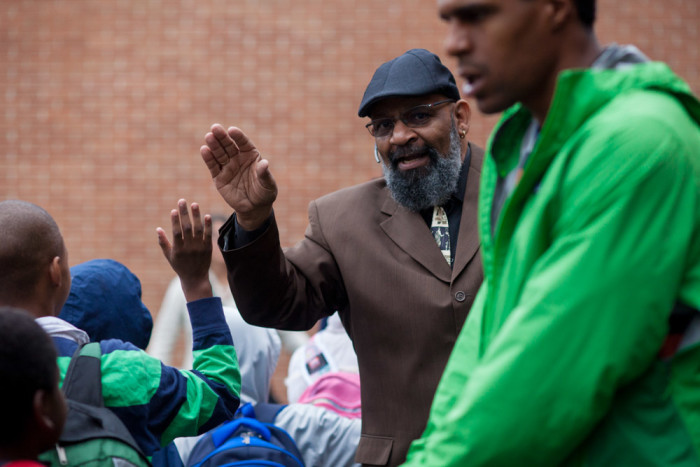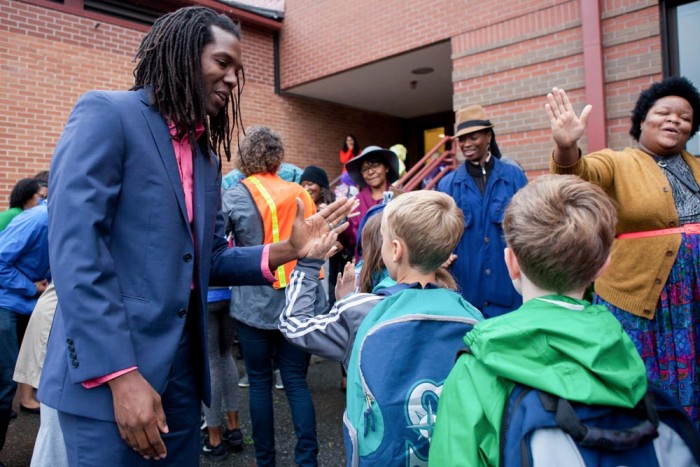Co-written by Shanelle Donaldson West

A few weeks ago we were very touched reading an article about a hundred Black men in Hartford, Connecticut who got together to greet and encourage children on the first day of school. They did it because they wanted to show children of color positive images of Black people in their community instead of the negative and damaging images commonly portrayed in the media.
We loved the idea so much we decided to bring it to Seattle. And with the outstanding and enthusiastic support of Shanelle’s father, Gerald Donaldson, a Family Support Worker at Leschi Elementary School, we held an amazing #SeattleHigh5 at Leschi Elementary last Friday morning to congratulate students for finishing their first week of school.
Our #SeattleHigh5 was inspired by the national #BlackLivesMatter (BLM) movement which is making profound strides to uplift the humanity, beauty, and innate value of Black lives — lives which have been denigrated in America since our nation’s inception. We strove to honor the BLM movement by interrupting messages of Black devaluation before they become embedded: emphasizing early intervention and working to undo anti-Black racism in partnership with the youngest members of our society.
Many people don’t realize children learn about race incredibly early and by five years old have developed very advanced racial understandings, biases and prejudices. This can mean biases towards others but also internalized biases damaging to themselves.

Shanelle, for example, grew up in Kirkland and was always either the only or one of very few Black or people of color (POC) kids in her class. This was in the 80’s and 90’s, so many of the images of Black people portrayed in the media were gang members, hip hop artists, drug addicts or servants. The only familiar image for her was The Cosby Show. Most of her teachers were white. All of this meant it was rare that Shanelle saw people who looked like her doing things outside of entertainment, sports, or something illegal.
Sharon grew up in Los Angeles and remembers being at school the day the L.A. riots began; smelling smoke from down town; feeling the panic of adults; watching students being sent home early to hole up in their houses in wealthier, protected neighborhoods. As a child she was immediately cognizant of something important transpiring and of the gaping disparities in the way it was transpiring.
Yet other than hearing mention of the racist verdict on TV, there were never any transformative educational experiences offered to her by adults. Almost everything else she learned about the riots was from the fear she felt in those around her and from the biased, violent imagery being trotted out again and again by the news during riot coverage.
Our own stark childhood experiences of anti-Black racism, combined with certain knowledge that children today still battle the same — often without much support from adults, lead us to a very clear goal in organizing #SeattleHigh5: Work with all children to interrupt anti-Black stereotypes at a time when it matters most.
Imbued by that spirit we wrote a pre-event letter to Leschi Elementary parents and guardians to help them prepare not only their children but also themselves (knowing full well adults are equally as vulnerable to anti-Black stereotyping):
This Friday morning on the way into school you will see a line of outstanding Black community member volunteers lined up to cheer on your children… Please prep your children the night before with a simple conversation (e.g. “something very exciting is happening at school tomorrow’’) and encouragement to participate (e.g. “you can just say hi, wave, or give a high-five’’). Please also mention skin color (“you’ll see the high-fivers have brown skin”), why that matters (“sometimes people with brown skin are not treated nicely which isn’t fair’), and your commitment to change (“but in our family we believe everyone should be treated fairly”).

Then Friday morning, September 25, over twenty enthused African American Greeters dressed to the nines in occupational/business attire, turned out to join our high five line (plus additional press and support volunteers).
#SeattleHigh5 Greeters included Black men, women and some of their young children.
The morning was cooler than what Seattle has been used to these last months and a light rain drifted down. But that didn’t matter at all. Once the bell rang and Leschi students filed toward our group, everyone kicked into high gear. There was cheering and whooping, smiles etched across everyone’s faces, high fives (and low fives) all over the place, waves and hellos, and happiness. Simply put, it was simply awesome.
Here’s the truth. More Black men are going to college than ever before in U.S. history. Black fathers living with their children are more likely to take on everyday child care duties than fathers in other demographic groups.
Yet many portrayals of Blacks in the media continue to focus on the negative; on outdated stereotypes that neglect the breadth and depth of their real lived lives. Last week was also the week that Viola Davis became the first African American to win Emmy for Best Actress in Drama. In her historic acceptance speech she quoted Harriet Tubman:
“In my mind, I see a line. And over that line I see green fields and lovely flowers. And beautiful white women with their arms stretched out to me over that line. But I can’t seem to get there no how. I can’t seem to get over that line.” That was Harriet Tubman in the 1800s. And let me tell you something, the only thing that separates women of color from anyone else, is opportunity. You cannot win an Emmy for roles that are simply not there… So here’s to all the writers, the awesome people… people who have redefined what it means to be beautiful, to be sexy, to be a leading woman — to be Black.
Nationwide children of color have become a majority in public schools yet the number of teachers of color has plummeted. Today 80 percent of school teachers are white and a new W.E. Upjohn Institute for Employment Research study exploring teacher bias confirms white teachers are much less likely to see Black students as college material. In Seattle Public Schools (SPS), from elementary through high school, Black students are suspended three times as often as white students. It was only two years ago that SPS was investigated by the Feds for this racist disciplining.

Children of color are receiving messages very early that they’re not as valued as other children through what they see (or don’t see), what they feel and hear, and how they’re treated. They then tend to internalize these negative stereotypes, which then impacts their level of trust, engagement, effort and success in the classroom. Researchers say that changing this dynamic is crucial if schools want to give every student the same chance.
With #SeattleHigh5 we wanted to launch a small school effort that could make a BIG difference. We wanted to forge our own positive, visible messages; give children of color an experience that showed them — and their peers — they are as important as anyone else and more, that they can grow to become outstanding adults like the ones that high-fived them that day.
There remains a dearth of experiences available to children of color that affirm, celebrate and uplift who they are. And when children of color learn to feel bad about themselves, they are pushed to step back and to not succeed. Meanwhile the mainstream keeps reinforcing negative ideas about people of color and invisibilizing POC successes so that the public psyche becomes continually convinced anti-Black ideologies are a reality. This is how stereotypes persist, reinvigorate and reinvent themselves over and over across time.
Seattle and its children needed #SeattleHigh5 more than can be expressed. We hope this was just the first of many, many more to come; growing ripples in a big pond. Because the smallest acts — and the smallest people — can sometimes truly make the biggest difference.
This post has been updated since it was first published. An older version misspelled the name of one of the participants.

